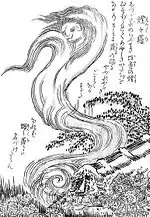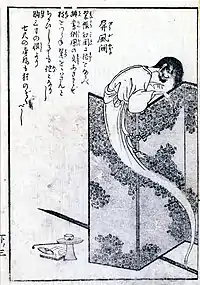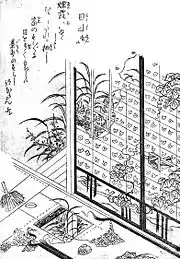Konjaku Hyakki Shūi (今昔百鬼拾遺, "Supplement to The Hundred Demons from the Present and the Past") is the third book of Japanese artist Toriyama Sekien's Gazu Hyakki Yagyō tetralogy, published c. 1781. These books are supernatural bestiaries, collections of ghosts, spirits, spooks and monsters, many of which Toriyama based on literature, folklore, and other artwork. These works have had a profound influence on subsequent yōkai imagery in Japan. Konjaku Hyakki Shūi is preceded in the series by Gazu Hyakki Yagyō and Konjaku Gazu Zoku Hyakki, and succeeded by Gazu Hyakki Tsurezure Bukuro.
A version of the tetralogy translated and annotated in English was published in 2016, which included this work, whose title is rendered as More of the Demon Horde from Past and Present.[1]
List of creatures
The three volumes were titled Cloud (雲), Mist (霧), and Rain (雨).[2]
First Volume – Cloud

 Shokuin (燭陰, torch in the yin) is the spirit of China's Purple Mountain. It appears as a red, man-faced dragon, a thousand ri tall, and is known as Zhuyin in China.[4]
Shokuin (燭陰, torch in the yin) is the spirit of China's Purple Mountain. It appears as a red, man-faced dragon, a thousand ri tall, and is known as Zhuyin in China.[4] Ninmenju (人面樹, human-faced tree) is a tree that grows in remote mountains recesses, with flowers that resemble human faces. These faces are always smiling, even as they fall from their branches. Based on similar trees described in the Chinese Sancai Tuhui.[5]
Ninmenju (人面樹, human-faced tree) is a tree that grows in remote mountains recesses, with flowers that resemble human faces. These faces are always smiling, even as they fall from their branches. Based on similar trees described in the Chinese Sancai Tuhui.[5]
 Hangonkō (ja:反魂香, 反魂香, soul-raising incense) is magical incense which can conjure up the spirits of the dead, originally described in Bai Juyi's Poetry of Lady Li.[7]
Hangonkō (ja:反魂香, 反魂香, soul-raising incense) is magical incense which can conjure up the spirits of the dead, originally described in Bai Juyi's Poetry of Lady Li.[7]

 Dōjōji no kane (道成寺鐘, the bell of Dōjō-ji temple) is the bell which was melted by Kiyohime, a woman who fell in love with a young priest, and through the rage of unrequited love became a terrible serpent demon. When the priest fled and hid underneath this temple bell, the serpent surrounded the bell and destroyed herself and her would-be lover in flames of her rage.[10]
Dōjōji no kane (道成寺鐘, the bell of Dōjō-ji temple) is the bell which was melted by Kiyohime, a woman who fell in love with a young priest, and through the rage of unrequited love became a terrible serpent demon. When the priest fled and hid underneath this temple bell, the serpent surrounded the bell and destroyed herself and her would-be lover in flames of her rage.[10] Tōdaiki (ja:灯台鬼, candle-stand demon) is a mute man with a candle on his head, sitting at the top of a lighthouse in China. According to legend, he was originally known as the Karu Minister, who went missing while on a mission to the Tang Dynasty. His son later traveled to China to find his missing father, only to discover he had become the Tōdaiki at the top of a lighthouse.[11]
Tōdaiki (ja:灯台鬼, candle-stand demon) is a mute man with a candle on his head, sitting at the top of a lighthouse in China. According to legend, he was originally known as the Karu Minister, who went missing while on a mission to the Tang Dynasty. His son later traveled to China to find his missing father, only to discover he had become the Tōdaiki at the top of a lighthouse.[11] Dorotabō (ja:泥田坊, muddy rice field fellow) is the ghost of an old man who worked hard to pass on his rice fields to his descendants. His children squandered the fields and sold them to someone else, and so the old man appeared in the fields as a black, one-eyed creature crying for his rice fields to be returned.[12]
Dorotabō (ja:泥田坊, muddy rice field fellow) is the ghost of an old man who worked hard to pass on his rice fields to his descendants. His children squandered the fields and sold them to someone else, and so the old man appeared in the fields as a black, one-eyed creature crying for his rice fields to be returned.[12] Kokuribaba (ja:古庫裏婆, hag of the old priest's quarters) was a woman who came to a mountain temple and was called the head priest's wife, because she lived in his quarters. She stole rice and money from the people who came to the temple, and as punishment became a terrible demon hag who eats the skin from corpses.[13]
Kokuribaba (ja:古庫裏婆, hag of the old priest's quarters) was a woman who came to a mountain temple and was called the head priest's wife, because she lived in his quarters. She stole rice and money from the people who came to the temple, and as punishment became a terrible demon hag who eats the skin from corpses.[13] Oshiroibaba (ja:白粉婆, face-powder hag) is an old woman who is the assistant of Jibun Senjō, the spirit of face powder. She walks through the snow during the twelfth month of the lunar calendar, wearing an oversized sugegasa hat.[14]
Oshiroibaba (ja:白粉婆, face-powder hag) is an old woman who is the assistant of Jibun Senjō, the spirit of face powder. She walks through the snow during the twelfth month of the lunar calendar, wearing an oversized sugegasa hat.[14]

 Kerakera-onna (ja:倩兮女)
Kerakera-onna (ja:倩兮女)
Second Volume – Mist
![Momiji [ja] (紅葉狩) is the demon-woman of Mount Togakushi.](../I/SekienMomijigari.jpg.webp)
 Oboroguruma (ja:朧車) is an ox cart with a huge human face on the front, which appears on hazy moonlit nights in Kyoto.[19]
Oboroguruma (ja:朧車) is an ox cart with a huge human face on the front, which appears on hazy moonlit nights in Kyoto.[19]
 Minobi (ja:蓑火)
Minobi (ja:蓑火)
 Ame-onna (ja:雨女) Rain making female spirit.
Ame-onna (ja:雨女) Rain making female spirit. Kosamebō (ja:小雨坊)
Kosamebō (ja:小雨坊) Gangikozō (ja:岸涯小僧)
Gangikozō (ja:岸涯小僧)


 Jatai (ja:蛇帯)
Jatai (ja:蛇帯) Kosode-no-te (ja:小袖の手)
Kosode-no-te (ja:小袖の手) Hatahiro (ja:機尋)
Hatahiro (ja:機尋) Ōzatō (ja:大座頭)
Ōzatō (ja:大座頭) Himamushinyūdō (火間蟲入道)
Himamushinyūdō (火間蟲入道) Sesshō-seki (殺生石, killing stone) is a stone in the volcanic mountains near Nasu, Tochigi Prefecture, said to kill anyone who comes into contact with it. It is believed to hold the spirit Tamamo-no-Mae.
Sesshō-seki (殺生石, killing stone) is a stone in the volcanic mountains near Nasu, Tochigi Prefecture, said to kill anyone who comes into contact with it. It is believed to hold the spirit Tamamo-no-Mae. Fūri (風狸, wind tanuki) is a flying creature with the body of a raccoon dog and the fur of a leopard. It originates from China, where it is known as the fengli.
Fūri (風狸, wind tanuki) is a flying creature with the body of a raccoon dog and the fur of a leopard. It originates from China, where it is known as the fengli.
Third Volume – Rain

 Yonaki ishi (ja:夜泣き石, stone that cries at night) are stones or boulders possessed by spirits that cry loudly at night. The most famous purported Yonaki ishi is located in Kakegawa, Shizuoka Prefecture.
Yonaki ishi (ja:夜泣き石, stone that cries at night) are stones or boulders possessed by spirits that cry loudly at night. The most famous purported Yonaki ishi is located in Kakegawa, Shizuoka Prefecture. Bashō no sei (ja:芭蕉精, bashō spirit) is the spirit of a bashō that takes on a human form. It is originally described in a Song Dynasty text entitled Can heartless plants also attain Buddhahood?, where it is known as the Bajiao Gui.[21][22]
Bashō no sei (ja:芭蕉精, bashō spirit) is the spirit of a bashō that takes on a human form. It is originally described in a Song Dynasty text entitled Can heartless plants also attain Buddhahood?, where it is known as the Bajiao Gui.[21][22] Suzuri-no-tamashii (ja:硯の魂, inkstone soul)
Suzuri-no-tamashii (ja:硯の魂, inkstone soul)
 Keukegen (毛羽毛現, fluffy hair appearance) is a small dog-like creature covered entirely in long hair. Sekien connects the Keukegen to Mao Nu, a similarly hairy spirit described in the Liexian Zhuan.
Keukegen (毛羽毛現, fluffy hair appearance) is a small dog-like creature covered entirely in long hair. Sekien connects the Keukegen to Mao Nu, a similarly hairy spirit described in the Liexian Zhuan.

 Mekurabe (目競, staring contest) is a pile of multiplying skulls that merges into a single large skull. It originates from The Tale of the Heike, where it menaces Taira no Kiyomori in his courtyard.
Mekurabe (目競, staring contest) is a pile of multiplying skulls that merges into a single large skull. It originates from The Tale of the Heike, where it menaces Taira no Kiyomori in his courtyard. Ushirogami (ja:後神, behind-spirit) is a female spirit with one eye on top of her head. She is said to appear behind people suddenly and pull on their hair.
Ushirogami (ja:後神, behind-spirit) is a female spirit with one eye on top of her head. She is said to appear behind people suddenly and pull on their hair. Iyaya (ja:否哉, lit. 'a slang expression meaning 'No way!'') is a female spirit who appears as a beautiful young woman from behind, but has the face of a wrinkly old man when viewed from upfront. Sekien connects Iyaya to a Chinese legend about Liu Che and Dongfang Shuo encountering an insect with a human head.
Iyaya (ja:否哉, lit. 'a slang expression meaning 'No way!'') is a female spirit who appears as a beautiful young woman from behind, but has the face of a wrinkly old man when viewed from upfront. Sekien connects Iyaya to a Chinese legend about Liu Che and Dongfang Shuo encountering an insect with a human head. Hōsōshi (方相氏, one who sees in all directions) is a four-eyed, sword-wielding exorcist who leads funeral processions and expels malevolent spirits. He originates from the Chinese Nuo folk religion, where he is known as Fangxiangshi.
Hōsōshi (方相氏, one who sees in all directions) is a four-eyed, sword-wielding exorcist who leads funeral processions and expels malevolent spirits. He originates from the Chinese Nuo folk religion, where he is known as Fangxiangshi. Takirei-ō (ja:滝霊王, waterfall king) is a spirit who appears behind waterfalls, believed to be an immovable Buddha (Fudō Myōō).
Takirei-ō (ja:滝霊王, waterfall king) is a spirit who appears behind waterfalls, believed to be an immovable Buddha (Fudō Myōō). Hakutaku (白澤, white marsh) is a creature that passes down knowledge of harmful spirits, based on the Chinese Bai Ze. In Japan it is typically depicted as a cow or cat creature with a nine-eyed human face.
Hakutaku (白澤, white marsh) is a creature that passes down knowledge of harmful spirits, based on the Chinese Bai Ze. In Japan it is typically depicted as a cow or cat creature with a nine-eyed human face. Kakurezato (隠れ里, hidden village) are remote, hidden villages often depicted as utopian refuges.
Kakurezato (隠れ里, hidden village) are remote, hidden villages often depicted as utopian refuges.
See also
References
- ↑ Yoda, Hiroko; Alt, Matt (2016). Japandemonium Illustrated: The Yokai Encyclopedias of Toriyama Sekien. Dover Publications. ISBN 978-0-486-80035-6.
- ↑ Toriyama Sekien 鳥山石燕 (1805). "Morin-ji [no] kama 茂林寺釜". Konjaku Hyakki Shūi 百鬼夜行拾遺 3巻(今昔百鬼拾遺). Vol. 1 (雲). Naganoya Kanbē.; 2 (kiri), 3 (ame).((in Japanese)
- ↑ 百鬼図譜「今昔百鬼拾遺雲之巻」しんきろう. park.org. Retrieved 2022-01-03.
- ↑ "百鬼図譜「今昔百鬼拾遺雲之巻」しょくいん". park.org. Retrieved 2022-01-03.
- ↑ "百鬼図譜「今昔百鬼拾遺雲之巻」にんめんじゅ". park.org. Retrieved 2022-01-03.
- ↑ "百鬼図譜「今昔百鬼拾遺雲之巻」にんぎょ". park.org. Retrieved 2022-01-03.
- ↑ "百鬼図譜「今昔百鬼拾遺雲之巻」はんごんこう". park.org. Retrieved 2022-01-03.
- ↑ "百鬼図譜「今昔百鬼拾遺雲之巻」ほうこう". park.org. Retrieved 2022-01-03.
- ↑ "百鬼図譜「今昔百鬼拾遺雲之巻」てんぐつぶて". park.org. Retrieved 2022-01-03.
- ↑ "百鬼図譜「今昔百鬼拾遺雲之巻」どうじょうじのかね". park.org. Retrieved 2022-01-03.
- ↑ "百鬼図譜「今昔百鬼拾遺雲之巻」とうだいき". park.org. Retrieved 2022-01-03.
- ↑ "百鬼図譜「今昔百鬼拾遺雲之巻」どろたぼう". park.org. Retrieved 2022-01-03.
- ↑ "百鬼図譜「今昔百鬼拾遺雲之巻」こくりばば". park.org. Retrieved 2022-01-03.
- ↑ "百鬼図譜「今昔百鬼拾遺雲之巻」おしろいばば". park.org. Retrieved 2022-01-03.
- ↑ "百鬼図譜「今昔百鬼拾遺雲之巻」じゃこつばば". park.org. Retrieved 2022-01-03.
- ↑ "百鬼図譜「今昔百鬼拾遺雲之巻」かげおんな". park.org. Retrieved 2022-01-03.
- ↑ "百鬼図譜「今昔百鬼拾遺雲之巻」えんえんら". park.org. Retrieved 2022-01-03.
- ↑ "百鬼図譜「今昔百鬼拾遺霧之巻」もみじがり". park.org. Retrieved 2022-01-03.
- ↑ "百鬼図譜「今昔百鬼拾遺霧之巻」おぼろぐるま". park.org. Retrieved 2022-01-03.
- ↑ "百鬼図譜「今昔百鬼拾遺霧之巻」かぜんぼう".
- ↑ 大和田建樹 (1896). 謡曲通解. Vol. 5 (増補 ed.). 博文館. pp. 14–21. doi:10.11501/876558.
- ↑ (無名). (in Chinese) – via Wikisource.
Further reading
- http://scene5.com/yokai/database/index/b3.htm
- http://park.org/Japan/CSK/hyakki/etc/obake_index-iroha.html
- Toriyama, Sekien (2005). Toriyama Sekien Gazu Hyakki Yagyō Zen Gashū. Kadokawa Sophia Bunko (in Japanese). Kadokawa Shoten. ISBN 978-4-04-405101-3.
- Natsuhiko Kyogoku; Katsumi Tada [in Japanese] (2000). Yōkai Zukan (in Japanese). Kokusho Kankokai (ja:国書刊行会). ISBN 978-4-336-04187-6.
- Kenji Murakami [in Japanese] (2000). Yōkai Jiten (in Japanese). Mainichi Shimbun. ISBN 978-4-620-31428-0.
External links
 Media related to Konjaku Hyakki Shūi at Wikimedia Commons
Media related to Konjaku Hyakki Shūi at Wikimedia Commons